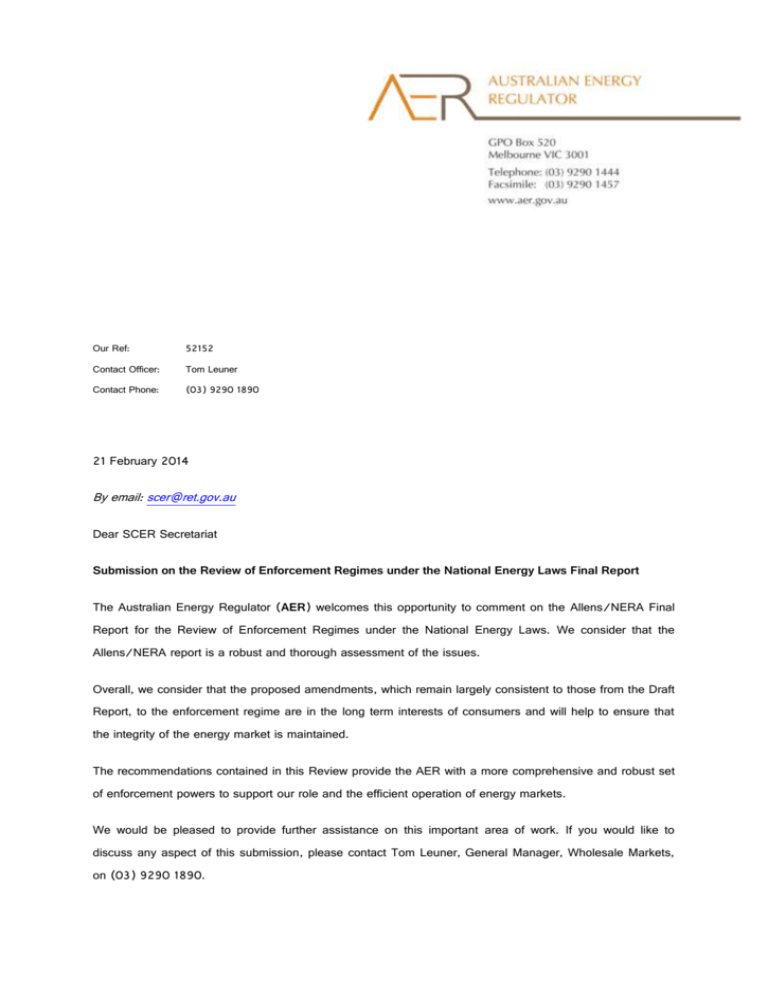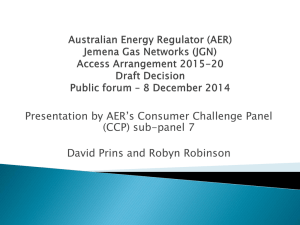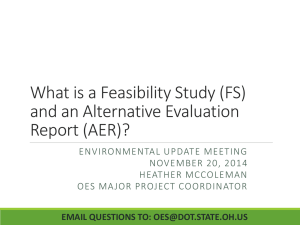Our Ref: 52152 Contact Officer: Tom Leuner Contact Phone: (03
advertisement

Our Ref: 52152 Contact Officer: Tom Leuner Contact Phone: (03) 9290 1890 21 February 2014 By email: scer@ret.gov.au Dear SCER Secretariat Submission on the Review of Enforcement Regimes under the National Energy Laws Final Report The Australian Energy Regulator (AER) welcomes this opportunity to comment on the Allens/NERA Final Report for the Review of Enforcement Regimes under the National Energy Laws. We consider that the Allens/NERA report is a robust and thorough assessment of the issues. Overall, we consider that the proposed amendments, which remain largely consistent to those from the Draft Report, to the enforcement regime are in the long term interests of consumers and will help to ensure that the integrity of the energy market is maintained. The recommendations contained in this Review provide the AER with a more comprehensive and robust set of enforcement powers to support our role and the efficient operation of energy markets. We would be pleased to provide further assistance on this important area of work. If you would like to discuss any aspect of this submission, please contact Tom Leuner, General Manager, Wholesale Markets, on (03) 9290 1890. Yours sincerely Andrew Reeves Chairman Australian Energy Regulator Introduction The AER’s decision making is guided by the objectives set out in national energy legislation. These aim to promote efficient investment in, and efficient operation and use of, energy services for the long term interests of energy consumers with respect to price, quality, safety, reliability and security of supply. A robust enforcement regime that has a range of enforcement options available to the regulator is important for the achievement of this statutory objective. It delivers credible deterrence to non-compliance and meaningful consequences for businesses that adversely affect consumers or create risks to the efficient and reliable operation of the market through non-compliance. We only take statutory enforcement action when necessary, consistent with our public statements of approach to compliance and enforcement.1 Since our establishment in 2005, we have served 11 infringement notices over six occasions (i.e. multiple notices on some occasions) in relation to alleged breaches in wholesale energy markets and two in retail markets since the commencement of the National Energy Retail Law (Retail Law). We have instituted court proceedings on only one occasion. The vast majority of significant compliance issues are addressed through administrative resolution; that is, by seeking voluntary commitments from businesses to remedy compliance issues. There are also many minor breaches that we assess and choose not to pursue. We support the principle that there should be consistency in enforcement regimes across the National Electricity Law (Electricity Law), the National Gas Law (Gas Law) and the new Retail Law. This provides predictability and certainty, allowing the regulated community to know where it stands. It also allows consistency in our approach, which has positive implications for our resourcing. We support the majority of the Final Report’s recommendations as they propose a wider range of enforcement options for the AER and participants, and a wider range of orders for the courts. Comments on particular conclusions/recommendations are provided below. The Final Report Conclusions/Recommendations on Statutory enforcement action The Final Report made the following conclusions/recommendations: 1 For wholesale markets, see Compliance and Enforcement Statement of Approach, December 2010; for retail markets, see Statement of approach: compliance with the National Energy Retail Law, Retail Rules and Retail Regulations, July 2011. Giving the AER power to issue compliance orders was not recommended because the additional enforcement power it confers on the AER may be disproportionate to the perceived gap in the effectiveness of the AER's current powers. A preferable approach is for the EMRWG to consider designating as additional civil penalty provisions those provisions identified by the AER, and confirmed through further stakeholder consultation, as creating a material enforcement issue under the current regime. If, contrary to this view, the EMRWG wished to introduce a power for the AER to issue compliance orders, the statutory provisions establishing the power should include an express right to challenge a compliance order made by the AER by court proceedings. The Draft and Final Reports discussed providing an additional enforcement power, short of court proceedings, in relation to provisions that are not civil penalty provisions. This would allow the AER to issue a regulated entity with a direction to comply and failure by the entity to do so would constitute a civil penalty provision. This option was not recommended in the Draft or Final Reports as it was considered that the additional enforcement powers conferred on the AER might be disproportionate to the perceived gap in the effectiveness of the current enforcement regime. Contrary to the conclusion of the Draft and Final Reports, the AER considers that the ability to issue such compliance orders would complement our current approach to enforcement and proportionately extend the available enforceable options for provisions that are not subject to civil penalties. We consider the current gap in the enforcement regime for these provisions to be significant, as the only formal option available to us is to seek court orders. As stated in the Draft and Final Reports, it is unlikely that the commitment of financial and other resources needed for court proceedings will be warranted for these types of provisions. Seeking a court order can be a time-consuming process and in many cases, the nature of the contravened provision may be such that court orders are an ineffective or disproportionate remedy. While administrative compliance work by the AER has been effective on many occasions, sometimes even after significant effort and repeated administrative commitments, significant breaches continue to occur. The work the AER does in addressing matters through administrative resolution is only sustainable if we also have the option of taking proportionate formal enforcement action. We consider that cases of repeated non- compliance for non-civil penalty provisions sometimes occur because regulated entities do not regard court action as a credible option for the regulator. Many provisions that are not classified as civil penalties would benefit from the compliance order option. For example, the requirement on electricity network businesses to carry out a Regulatory Investment Test to identify the network investment option which maximises net economic benefits. On numerous occasions AER has requested network businesses to repeat the test where we have identified shortcomings in their original application of it. While businesses have stated they will meet these requests, the AER has no further options, short of seeking a court order, that it can take if the business did not follow the AER’s request. If allowed to issue a compliance order, the AER could issue a direction requiring the business to repeat the test without employing the resources required to go to court. As this example highlights, a compliance order would provide an effective lower level enforcement tool, which would act as a deterrent to the business concerned and others in the sector. Similar arguments could be applied to our dealings with compliance issues for the provision of metering data, annual network planning requirements, requirements for gas market allocation data and retail complaints handling. It is unlikely that the AER would use compliance orders as a first response, but rather as a follow-up step where initial (voluntary) administrative actions prove unsuccessful. We consider that having the ability to make these orders will strengthen the effectiveness of developing initial administrative solutions and reduce the occurrence of repeated breaches of provisions not classified as civil penalties. Consistent with all formal enforcement actions, compliance orders would only be issued upon approval of the AER Board. Moreover, if the AER were to issue an infringement notice for breaching a compliance order, the recipient has the option of not paying and forcing the AER to take the matter to court. It is this latter option available to recipients which acts as an important check on the AER’s enforcement decisions, helping to avoid the disproportionate use of this new power. Where SCER does introduce the power for the AER to issue compliance orders, the Final Report recommended that there should be an express right to challenge a compliance order made by the AER. We consider such a review process to be prudent as it provides a safeguard for businesses that the AER will only issue a compliance order where appropriate. A review process addresses concerns expressed in the Report around the perceived material increase in power that compliance orders would confer on the AER. The Final Report suggested that a preferable approach to compliance orders may be for SCER to designate additional provisions as civil penalties, based on stakeholder consultation and the AER’s consideration of current gaps in the enforcement regime. While the AER’s preference would be to have the power to issue compliance orders, we see the expansion the current civil penalty regime to include other provisions as a significant and important improvement to the status quo. The Final Report Conclusions/Recommendations on Conduct Provisions The Final Report recommended the following provisions be designated as conduct provisions: (a) Preventing or hindering access – NEL, s157 (b) Connections framework – the provisions of the NEL and NER listed in Part A of Appendix 6 (c) Connections framework – the provisions of Chapter 5A of the NEL and Part 12A of the NGL listed in Part B of Appendix 6 (d) Retail support rules – the provisions in Part 5 of the NERR (e) 'B2B' life support equipment rules – clause 124(1)(a), (b) and (c), clause 124(2) and clause 126 of the NERR; and (f) Pre-contractual obligations in the energy marketing rules – clause 62 of the NERR. The current conduct provisions regime in National Energy Laws allows for the private enforcement of regulatory obligations. This allows a person other than the AER to seek a court order declaring that another person is in breach of a designated provision. In general, conduct provisions apply to the conduct of one industry participant that will directly affect another industry participant. Our submission to the Draft Report agreed that a number of provisions relating to electricity connections would be appropriate conduct provisions. We also suggested that a number of the ‘business-to-business’ retail obligations would be suitable conduct provisions, given the interdependence of these businesses in achieving compliance. We support the Final Report’s recommendations on conduct provisions and consider that it would be beneficial for there to be a periodic review of the classification of conduct provisions. The Final Report Conclusions/Recommendations on Penalties SCER should consider initiating a further targeted review, including the opportunity for further stakeholder consultation, to assess whether there are any specific additional provisions of the National Energy Laws, Regulations or Rules that should attract the higher maximum penalty rate of $1,000,000 for bodies corporate and $200,000 for individuals. Such a review may be more appropriate after a period of further experience with the operation of the NECF. The NEL should be amended to provide that the maximum penalty for a rebidding civil penalty provision is the higher of $1,000,000 (being the current maximum) and a multiple of three times the total value of the benefits derived from the contravention by the person found to have contravened the provision. SCER should consider whether this is an appropriate time for a uniform increase in civil penalty rates to reflect changes in the value of money since the current penalty rates were set. We support the Final Report’s recommendation that the maximum civil penalty level of $1 million for bodies corporate should be extended to cover other provisions in the Energy Laws and Rules (the higher penalty currently applies only to the wholesale electricity good faith rebidding provision). We agree that it will provide an effective deterrent for non-compliance and better reflect the seriousness of certain offences. We consider the Final Report’s illustrative examples of the economic benefits of civil penalty provision breaches to clearly demonstrate the potentially significant financial gains which a regulated entity obtain as a result of non-compliance. The Draft Report invited submissions on which provisions should be subject to this higher penalty. The AER’s submission provided a non-exhaustive list of possible provisions, including provisions for which: non-compliance could result in potentially significant financial gains for a regulated entity a breach could have significant consequences on energy supply security or consumers the entity is required to dedicate resources (directly or indirectly) to the maintenance of systems and processes. Based on submissions received to the Draft Report, the Final Report considered that the enforcement regimes would be enhanced by subjecting more civil penalties to the higher penalty. However, it considered the task of deciding which provisions should attract the higher penalty to be complex and, as noted above, recommended that SCER conduct a targeted review (with opportunities for stakeholder consultation) on this matter. We agree with this approach and will be glad to offer input to this process. As noted above, the Final Report also recommended that the maximum penalty for the rebidding civil penalty provision be amended to be the greater of $1 million (the current maximum) and a multiple of three times the total value of benefits derived from the non-compliance. We agree with this recommendation and, consistent with our submission to the Draft Report, suggest that this recommendation should be extended to any other provisions which are amended under this Review to have the $1 million maximum civil penalty and have financial benefits of non-compliance (for example, the requirement to follow dispatch instructions). Where there are difficulties associated with calculating the gains derived from contravention, we consider that a precedent has been set for such calculations under other enforcement regimes where similar penalty methods have been used successfully (such as in the U.S. energy sphere and in the context of cartel matters). Regardless, the $1 million penalty remains an alternative option if the gains are difficult to calculate. The Final Report also contemplated an increase in civil penalty levels to take account of inflation since the penalty levels were first set in 1998 and the $1 million maximum penalty was introduced in 2003. It notes that it is usual practice for penalty levels in all legislative and regulatory regimes to be reviewed periodically and adjusted to ensure that the real value of the penalties is maintained over time. We support SCER considering whether a general increase in civil penalties across the National Energy Laws is now appropriate. We consider it to be consistent with other enforcement regimes, as well as with similar adjustments which are made under National Energy Laws, such as the annual adjustment to the electricity market price cap. The Final Report Conclusions/Recommendations on Gathering information under Oath The Final Report recommended that the National Energy Laws should be amended to give the AER the power to require a person to provide information on oath or affirmation where the information to be provided relates to a matter that constitutes, or may constitute a contravention of the National Laws or Rules. We support this recommendation and consider it is essential to ensure an effective enforcement regime. We agree with the Final Report’s conclusions that the ability to compel evidence under oath would enable the AER to more effectively fulfil its investigative and enforcement function by providing the AER with a greater ability to investigate breaches which include a mental element and to test the accuracy of written evidence which may be otherwise unclear or inconclusive. It also allows for evidence to be furnished by witnesses who are no longer associated with the party under investigation (for example, an employee who is no longer working for the party and would therefore not be involved in preparing a written response to an information request). Having better quality information to guide investigations will allow the AER to make more informed conclusions of whether there has been a breach and therefore avoid costly and resource intensive litigation. The Final Report’s commentary of the AER’s court case against Stanwell clearly demonstrates a situation where an investigation would have run more efficiently had the statements of witnesses been available to the AER as part of the investigation. The Federal Court highlighted that there were differences between the written responses to the AER’s compulsory written information requests and the oral evidence which was given in court. The Report recognises that these inconsistencies would most likely have been clarified had the AER been able to question the relevant parties under oath prior to the court proceedings rather than relying solely on written responses. The Final Report noted that the working relationships between these businesses and the AER will be significantly influenced by the way in which the power is exercised by the AER and the statutory protections surrounding it. We agree that these issues go to the design and use of the power, rather than whether the power is warranted. The AER would only use this additional power out of necessity, and only upon Board approval. Having this power would not alter our approach of having less formal discussions with businesses and seeking administrative solutions where this would achieve the most appropriate outcome. As the Final Report outlines, similar powers compelling the provision of written or oral evidence under oath are common among regulators of other fields within Australia, as well as energy regulators in other jurisdictions. Specific examples of powers given to international energy regulators who have similar roles to the AER include: United States of America – the Federal Energy Regulatory Commission can administer oaths and affirmations, subpoena witnesses, compel their attendance, take evidence and require the production of any documentation relevant to the investigation. Alberta, Canada – the Market Surveillance Administrator can, for the purposes of carrying out its role, make reasonable inquiries of current or former employees or contractors of an electricity or gas market participant and require information to be provided under oath. Ontario, Canada – the Market Surveillance Panel has the power to examine and compel the production of documents or other things, to summon and compel testimony and to enter premises for the purposes of an investigation. United Kingdom – the Office of Gas and Electricity Markets may require any person to answer questions (where it is an offence to provide false or misleading information in response) and to give all assistance with the investigation which the person is reasonably able to give. These powers assist the regulators to carry out effective investigations. We consider the AER’s investigations would benefit similarly if our current range of investigative options was expanded to include the power to compel evidence under oath.








